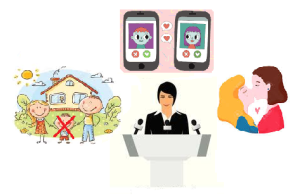Week 4
Date: 25 Jan 2021
Motion: THB almost all diets (alike most religions) lead a citizen to weal
Role: Whip (opp.)
This has been a fantastic debate that has touched upon the nerves of people, as everyone has an opinion on what to eat and what to think about what his or her neighbour eats, too. I think our side has debunked the idea that any diet can be good for you as long as it restricts the amount of calories taken in. Patently this is not the case. Among diets, just as among religions, there are the scientologies and the Urantia books, whose aim is not to set up the citizen for an altogether better life, but rather to dupe him into parting with his money and free will.
Even though our side acknowledged the merits of some diets that they have tried, too, I want to focus on the most basic “good” diet, the so-called food pyramid. It was developed by Swedes in 1974 and adopted by the USDA in 1992. People had been vegetarian before, but they did it on their own devices and dime, whereas the food pyramid came as guidance from the state. Its idea is this: eat as much as you want off the bottom and eat as little as you can from the top. It seems that people still do not get it, because they have reversed it so that they crave clearly too much what lies on (the way to) the top; i.e. the less harmless stuff. The most up-to-date pyramid that I have seen has vegetables, root vegetables, fruit and berries on the bottom, and I base my speech on that pyramid. In the next, I will go through how a segment of people, respectively, goes against the grain of the pyramid’s true content and message.
People Who Eat a Surfeit of Carbohydrates
It’s easy to overindulge in carbohydrates. They are readily available in a multitude of products that tend to have a long shelf life. They come fiber-rich, which is good, and fiber-poor, which is bad. One can safely assume that there would not be billions of people today if someone had not invented bread and cereals at some point. People (used to) love bread. A normal baguette or sliced bread in a home setting is usually layered with all kinds of extras, and that in its own right begins to build up fat and eat away at health. A typical person who eats too much bread or carbs on a daily basis, just stores the excess amount of energy as fat tissue in his or her body. Fat accumulates around all internal organs, not just the stomach bag. Driven to the extreme, this will result in diabetes B. Our Secretary took a firm stand against excessive carbs.
People Who Eat a Surfeit of Protein or Dairy Products
Bodybuilding among men, fitness among women, man’s natural craving for animal meat, especially barbecued and grilled, coupled with some well-known dieticians, seem to be a driving force why a growing number of people try to keep meat as their number #1 source of energy and vitamins. This is often combined with an aversion to carbohydrates and sugar, making the adherents disown, say, beer. Dairy products follow in the same footsteps as meat, as they often contain protein as well, being mammals’ first meal from their mothers’ teats. It has been reported that exercising people feel fatigue on too high a protein-based diet, and carcinogens are also a major issue here. This bent of folks was the target of our MP, conversant as she is with that.
People Who Eat a Surfeit of Fats or Other High-Density Products
I would presume fewer people want to favour fats over the other food groups in their diet. There are some exceptions to this rule, such as inuits who live in Siberia and Greenland and who have learnt to survive in focussing on the most calorie-rich parts of seal meat, which is the fat tissue. It goes without saying that they may not care too much for green things, in the winter at least. In the summer, they may recompensate… There are also Westerners who put olive oil in everything or butter in every side serving. It can be said that some people “favour fat”. What’s more, we should juxtapose fats with everything else that people can put down their throats, on top of the pyramid. The original food pyramid omitted unnatural foodstuffs coyly, mentioning only sweets. We all know people whose intake centers to a great extent on these mega- or meta-products. Somehow they stay alive from year to year. But, it cannot be good for them. This was the pet peeve of our Chair.
People Who Eat a Surfeit of Plant-Based Products
What has gone hitherto un(der)mentioned is a vegetarian or a vegan lifestyle. In that case, vegetarians and vegans should be seen as presiding over a pyramid of their own, where grains and veggies not only constitute their own compartment but also replace dairy products, proteins and fats; in part, or entirely. What’s noteworthy about this competing pyramid is that it would have some extra ingredients at the top, next to fats. As vegans cannot get all their B-vitamins and some other necessary vital substances from the flora easily, they need to use dietary supplements and take them from a pill bottle. As with meateaters, their “sin compartment” at the top of the pyramid would likewise exist indeed.
It seems that there is a big temptation for food lobbies and sundry dieticians, as opposed to vegetable growers, to lobby for their products to replace greens as the bottommost staple, which would, in theory, lead to an upsurge in the demand. Here one such view. Why are berries, fruit, root vegetables and vegetables the most recommendable food group for a human being to eat? I can come up with three explanations. a) The foodstuffs are in order of caloric density. Greens have the lowest density, as they contain so much water. b) They are in order of how much lipids they include, and in this context alcohol may be regarded as just another lipid, as its caloric value is the same. Agains, greens have the lowest rate, close to zero. Or, c) Foods may be in order of how much they are considered carcinogenic and conducive to heart and blood-vessel disease. Greens are not entirely without guilt, as they too, are sprayed with pesticides and poisons, but in the long run, they are probably the least carcinogenic of the whole pyramid.
The pyramid in its own right teaches people to eat right, but despite its simplicity its presentation may be wrong. People automatically tend to think what is on top, is good for you, and what is on bottom, is bad for you, whereas the truth is the reverse. It’s clear that LITERACY perhaps does not lead to NUMERACY and even less to “VISUALACY”, the ability to interpret scientifically devised, visually explicit diagrams and graphs in an appropriate way. Maybe the pyramid would need to be upended, laid upside down, in order to be understood in the right manner. Or, perhaps it is the caveman instincts that are the culprit, hurdle and underlying reason for our desire to eat like our forebears did, with the emphasis on the word part “bear“. But, truth be told, even bears eat much more healthy — think berries, honey and salmon — than a significant percentage of people.
Perustelu(t)/puolustelu(t): Whip-puheeksi tässä on hyvää se, että esitän kokonaisnäkemyksen asiasta tavalla, jolla sitä eivät aiemmat puhujat olisivat välttämättä edes voineet tehdä. Näin whipin roolissa toistuu sama, kuin mitä ollaan sanottu kääntäjien roolista: hän “paitsi heijastaa valoa myös luo sitä lisää.” Whipin sanomaksi jää se, että ruoan kanssa ei pitäisi kikkailla ja että ei ole kovin monta oikeaa tapaa syödä, vaikka maallikko voisi luulla muuta vallitsevassa informaatioympäristössä. Tämä puhe päättää kierroksen, jossa on käyty kaikissa rooleissa pöydän ympärillä.



